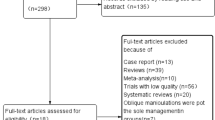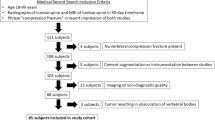Abstract
We wanted to evaluate how often safe and effective posterior C1-C2 transarticular screw placement is realizable when it is performed according to guidelines given in the literature. In 50 adult patients, computerized tomography scan data from C0 to C3 were transformed into a 3D spine model. Virtually, bilateral screws were placed from the medial third of the C2-C3 facet joint towards the rim of the C1 anterior arc parallel to midline. Three categories of virtual screw position were rated: optimal (virtual screw inside the C2 pars interarticularis, transversing the middle third of the atlantoaxial joint, and sparing the vertebral artery canal), suboptimal (virtual screw violating the C2 pars interarticularis, and/or transversing the lower or upper third of the C1-C2 joint, and sparing vertebral artery canal), and unacceptable (virtual screw breaching the vertebral artery canal). Optimal placement was seen in 74, suboptimal placement in 11, and unacceptable locations in 15 sites. We conclude that due to the variability of the anatomy of the upper cervical spine, optimal transarticular C1-C2 screw placement is not possible in up to 26%, and even hazardous in up to 15%.


Similar content being viewed by others
References
Bloch O, Holly LT, Park J, Obasi C, Kim K, Johnsom JP (2001) Effect of frameless stereotaxy on the accuracy of C1-2 transarticular screw placement. J Neurosurg 95:74–79
Campanelli M, Kattner KA, Stroink A, Gupta K, West S (1999) Posterior transarticular screw fixation in the treatment of displaced type II odontoid fractures in the geriatric population: review of seven cases. Surg Neurol 5:596–600
Coyne TJ, Fehlings MG, Wallace MC, Bernstein M, Tator CH (1995) C1-C2 posterior cervical fusion: long-term evaluation of results and efficacy. Neurosurgery 37:688–692
Dickmann CA, Foley KT, Sonntag VK, Smith MM (1995) Cannulated screws for odontoid screw fixation and atlantoaxial transarticular screw fixation. Technical note. J Neurosurg 83:1095–1100
Dickmann CA, Sonntag VK (1998) Posterior C1-C2 transarticular screw fixation for atlantoaxial arthrodesis. Neurosurgery 43:275–280
Ebraheim NA, Misson JR, Xu R, Yeasting RA (2000) The optimal transarticular C1-2 screw length and the location of the hypoglossal nerve. Surg Neurol 53:208–210
Farey ID, Nadkarni S, Smith N (1999) Modified Gallie technique versus transarticular screw fixation in C1-C2 fusion. Clin Orthop 35:126–135
Grob D, Crisco JJ III, Panjabi MM, Wang P, Dvorak J (1992) Biomechanical evaluation of four different posterior atlantoaxial fixation techniques. Spine 17:480–490
Grob D, Jeanneret B, Aebi M, Markwalder TM (1991) Atlanto-axial fusion with transarticular screw fixation. J Bone Joint Surg Br 73:972–976
Haid RW, Subach BR, McLaughin MR, Rodts GE Jr, Wahlig JB Jr (2001) C1-C2 transarticular screw fixation for atlantoaxial instability: a 6-year experience. Neurosurgery 49:65–70
Henriques T, Cunningham BW, Olerud C, Shimamoto N, Lee GA, Larsson S (2000) Biomechanical comparison of five different atlantoaxial posterior fixation techniques. Spine 25:2877–2883
Liang ML, Huang MC, Cheng H, Huang WC, Yen YS, Shao KN, Huang CI, Shih YH, Lee LS (2004) Posterior transarticular screw fixation for chronic atlanto-axial instability. J Clin Neurosci 11:368–372
Madawi AA, Casey TH, Solanki GA, Tuite G, Veres R, Crockard HA (1997) Radiological and anatomical evaluation of the atlantoaxial transarticular screw fixation technique. J Neurosurg 86:961–968
Magerl F, Seemann PS (1987) Stable posterior fusion of the atlas and axis by transarticular screw fixation. In: Kehr P, Weidner A (eds) Cervical spine I. Springer, Berlin Heidelberg New York, pp 322–327
Mitchell TC, Sadasivan AL, Ogden AL, Mayeux RH, Mukherjee DP, Albright JA (1999) Biomechanical study of atlantoaxial arthrodesis: transarticular screw fixation versus modified Brooks posterior wiring. J Orthop Trauma 13:483–489
Naderi S, Crawford NR, Song GS, Sonntag VK, Dickmann CA (1998) Biomechanical comparison of C1-C2 posterior fixations. Cable, graft, and screw combinations. Spine 23:1946–1955
Oda I, Abumi K, Sell LC, Haggerty CJ, Cunningham BW, McAfee PC (1999) Biomechanical evaluation of five different occipito-atlanto-axial fixation techniques. Spine 24:2377–2382
Paramore CG, Dickmann CA, Sonntag VKH (1996)The anatomical suitability of the C1-2 complex for transarticular screw fixation. J Neurosurg 85:221–224
Richter M, Schmidt R, Claes L, Puhl W, Wilke HJ (2002) Posterior atlantoaxial fixation: biomechanical in vitro comparison of six different techniques. Spine 27:1724–1732
Taggard DA, Kraut MA, Clark CR, Traynelis VC (2004) Case-control study comparing the efficacy of surgical techniques for C1-C2 arthrodesis. J Spinal Disord Tech 17:189–194
Wang J, Vokshoor A, Kim S, Elton S, Kosnik E, Bartkowski H (1999) Pediatric atlantoaxial instability: management with screw fixation. Pediatr Neurosurg 30:70–78
Weidner A, Wähler M, Chiu ST, Ulrich C (2000) Modification of C1-C2 transarticular screw fixation by image-guided surgery. Spine 25:2667–2674
Wilke H-J, Fischer K, Kugler A, Magerl F, Claes l, Worsdorfer O (1992) In vitro investigations of internal fixation systems of the upper cervical spine: stability of posterior atlanto-axial fixation techniques. Eur Spine J 1:191–199
Wright NM, Lauryssen C (1998) Vertebral artery injury in C1-2 transarticular screw fixation: results of a survey of the AANS/CNS Section on Disorders of the Spine and peripheral nerves. J Neurosurg 88:634–664
Author information
Authors and Affiliations
Corresponding author
Rights and permissions
About this article
Cite this article
Spangenberg, P., Coenen, V., Gilsbach, J.M. et al. Virtual placement of posterior C1-C2 transarticular screw fixation. Neurosurg Rev 29, 114–117 (2006). https://doi.org/10.1007/s10143-005-0003-7
Received:
Revised:
Accepted:
Published:
Issue Date:
DOI: https://doi.org/10.1007/s10143-005-0003-7




